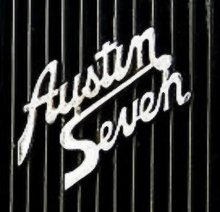| Austin 7 | |
|---|---|
 Austin Seven 1922 | |
| Overview | |
| Manufacturer | Austin |
| Production | 1923–1939 290,000 |
| Body and chassis | |
| Class | Economy car |
| Body style | 2-door tourer 2-door saloon 2-door cabriolet 2-door coupe 3-door van |
| Powertrain | |
| Engine | 747 cc straight-4 |
| Dimensions | |
| Wheelbase | 75 inches (1.9 m) |
| Chronology | |
| Predecessor | None |
| Successor | Austin 8, Austin Big 7 |
The Austin 7 is an economy car that was produced from 1923 until 1939 in the United Kingdom by Austin. It was nicknamed the "Baby Austin" and was at that time one of the most popular cars produced for the British market and sold well abroad. Its effect on the British market was similar to that of the Model T Ford in the US, replacing most other British economy cars and cyclecars of the early 1920s.[1] It was also licensed and copied by companies all over the world.[2] The first BMW car, the BMW Dixi, was a licensed Austin 7. In France they were made and sold as Rosengarts, and in the United States they were built by the American Austin Car Company. In Japan, Nissan also used the 7 design as the basis for their first cars, although not under licence.[2] This eventually led to a 1952 agreement for Nissan to build and sell Austins (which were now being made under the British Motor Corporation) in Japan under the Austin name.
Many Austin 7s were rebuilt as "specials" after the Second World War,[3][4][5] including the first race car built by Bruce McLaren, and the first Lotus, the Mark I. Companies such as Speedex in Luton thrived in the late 1950s by producing race-proven bodies and engine parts for the Seven chassis.
Such was the power of the Austin 7 name that the company re-used it for early versions of the A30 in 1951[6] and Mini in 1959.

- ^ Baldwin, N. (1994). A-Z of Cars of the 1920s. Bay View Books. ISBN 1-870979-53-2.
- ^ a b Mills, Rinsey (1996). Original Austin Seven. Bay View Books. ISBN 1-870979-68-0.
- ^ "Classic Motor Monthly: The Super Accessories". Classicmotor.co.uk. 27 December 1998. Archived from the original on 21 June 2012. Retrieved 23 June 2012.
- ^ "The Austin Seven Special". Pasttimesproject.co.uk. Retrieved 23 June 2012.
- ^ "Austin 7 Special". Tanygraig.force9.co.uk. Archived from the original on 21 March 2007. Retrieved 23 June 2012.
- ^ Robson, Graham (2006). A-Z British Cars 1945–1980. Herridge & Sons. ISBN 0-9541063-9-3.